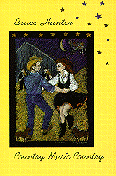


|
Country Music Country.
Bruce Hunter.
Grades 10 and up / Ages 15 and up. *** /4
|

excerpt:
How's your dad, people ask. And you just want to shriek; instead, you say fine, just fine. Fine, fine, fine. And no matter what you do you're going to feel the same way when he dies. Misplaced, maybe a little vague, but with this raw stinking guilt. Which you're going to shoulder until the day you die.Entertaining, connected short stories (many published previously in literary magazines) make up Country Music Country, Bruce Hunter's first collection.
The stories are set in Calgary from the 1950s to the present, an era that is effectively reproduced and, of course, familiar to many readers. The characters come from the blue-collar class of Canadian society, a group whose lives are not often explored in literature.
In this collection, Hunter focusses on a small group of children who attend the same school: Tom Grogan, who plays the role of the "connector;" Bob Adams, a Cree with an Irish mother, who wants to be white; Kenny Dawe, a rebel with no real purpose; and Adrian and Suzy Carp, the only ones who successfully pursue higher education and achieve a measure of happiness.
In the first story, "Blood Brothers," the stage is set. The children are 12 to 13 years old and absorbed in their play. They create forts, hatch plots, range over woods and, at one point, become blood brothers (even Suzy) in a ceremony that takes place in the wreck of a car. They all want to be "Indians," except Bob, who wants to be a pool shark.
Later stories reveal that the gang's experiences vary widely when they reach adulthood. In "The Many Happy Returns of Kenny Dawe," the reader learns that Kenny has become a petty criminal. We find out about Suzy's work as a horticulturist and her happy marriage in "Manitoba Maple" but we also discover her misery in dealing with her alcoholic father. In "Bad Eyes" we learn about Tom's experience on the night shift of a construction job and his relationship with Bernie, his boss, who wears glasses and studies but also stands his ground when a biker challenges him.
The stories also view the characters from the perspective of time, distance and even other characters. In "519," Tom's first love affair is described by his girlfriend in an almost lyrical story. In "Snake Island," Suzy and Adrian recall their childhood but Adrian makes it clear that he will not return home except for a funeral.
The final (and title) story finds Tom shattered by the death in prison of Kenny Dawe. He and Adrian take Kenny's ashes to a northern lake where they scatter them on the surface of the water. There, Adrian tells Tom that Kenny died of AIDS, which explains why his corpse looked like that of an old man, though he was only 36. Tom realizes that Kenny's lifestyle shouldn't matter, but somehow it does.
The grey worldview and downbeat mood in these stories is sustained throughout. The style is appropriate for the theme and the varied narratives move well. The cover, featuring a painting of square dancers by Kathi Posliffe, suits the topic. The print is clear making reading easy and pleasant. This collection deserves a wide reading. Students whose background is blue collar may find the stories particularly satisfying.
Recommended.
Katheryn Broughton was born in the prairies and taught high school English and Library skills for nineteen years in North York, Ontario. She has edited a book of short stories (entitled Heartland) for senior students. These days she writes about old houses for the historical society newsletter (which she edits) in her home town, Thornhill, Ontario.

To comment on this title or this review, send mail to cm@umanitoba.ca.
Copyright © 1996 the Manitoba Library Association. Reproduction for personal use is permitted only if this copyright notice is maintained. Any other reproduction is prohibited without permission.
Published by
The Manitoba Library Association
ISSN 1201-9364
AUTHORS |
TITLES |
MEDIA REVIEWS |
BOOKSHELF
BACK ISSUES |
SEARCH |
HOME